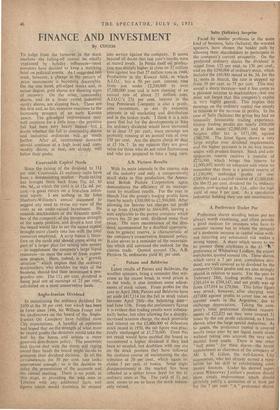A Preference Under Par Preference shares standing below par are
always worth examining, and often provide a good medium for investors who have to consider income but to whom the prospect of a moderate increase in capital value with. out incurring any substantial risk makes a strong appeal. A share which seems to me to possess these attributes is the LI "ik." preference of Whiteaway Laidlaw, the export merchants, quoted around 18s. These shares, which carry a 7 per cent. cumulative divi- dend, are well covered as to dividend by the company's latest profits and are also strongly placed in relation to assets. For the year to February 28th, trading profits rose' from £201,614 to £298,147, and net profit was up from £37,034 to £79,066. This latter figure was struck, however, after charging over £87,000 against profits to cover loss on net current assets in the Argentine, due to exchange depreciation. Taking the com- pany's total preference dividend require- ments of £22,825 net they were covered 31 times by the net profit calculated, as I have shown, after the large special deduction. As to assets, the preference capital is covered nearly twice over by net liquid assets alone without taking into account the very sub- stantial fixed assets.. There is one other
bull point " for these shares—the recent appointment as chairman of the company of Mr. S.' H. Gillett, the well-known City accountant, who has already earned a repu- tation for his skill in rehabilitating com- panies' finances. Under his shrewd super- vision Whiteaway ,Laidlaw's position should show steady improvement which should certainly justify a quotation of at least p.ir for the 7 per cent. " A " preference slim es.






















































 Previous page
Previous page